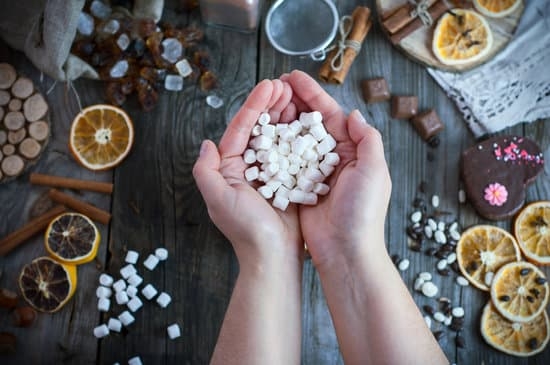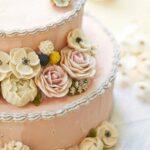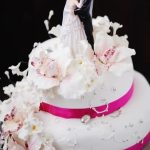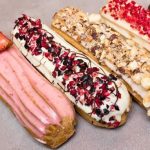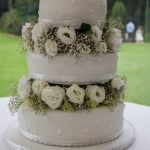Cake decoration is an essential aspect of the baking industry, adding not just visual appeal but also enhancing the overall experience of enjoying a delicious cake. From birthday celebrations to weddings, cakes have become a centerpiece of many joyous occasions, and the art of cake decoration plays a crucial role in making these moments memorable.
So, what do they use to decorate cakes in the baking world? The answer lies in a variety of techniques and tools that pastry chefs and bakers employ to create stunning edible masterpieces.
When it comes to decorating cakes, various types of icing are commonly used, each with its own unique characteristics and applications. Buttercream, fondant, royal icing, and ganache are some popular choices that offer different textures and finishes for cake decorations. These icings serve as the base for intricate designs that can transform a simple cake into a work of art.
Additionally, piping techniques play a crucial role in creating elaborate patterns, borders, and decorations on cakes. Pastry chefs use piping bags and tips to achieve precise details that elevate the overall look of the cake.
Another popular method for creating elaborate decorations on cakes is using fondant. This pliable sugar paste allows bakers to sculpt intricate shapes, figures, and flowers that can adorn cakes beautifully. Fondant offers versatility in design possibilities and enables pastry chefs to showcase their creativity through edible artistry.
In addition to fondant decorations, edible embellishments like sprinkles, edible glitter, and edible pearls are used to add texture and sparkle to cake designs. These small details can make a big difference in enhancing the visual appeal of a cake and making it truly special for any occasion.
Types of Icing
When it comes to decorating cakes, the type of icing you choose can make a significant difference in the final look and taste of the cake. There are several popular types of icing used in cake decoration, each with its unique characteristics and benefits. Here are some of the most common types of icing:
- Buttercream: Buttercream is a classic choice for cake decoration due to its creamy texture and ability to be easily colored and flavored. It is made from butter, powdered sugar, and flavorings, creating a smooth and spreadable consistency perfect for piping intricate designs.
- Fondant: Fondant is a versatile icing that can be rolled out into thin sheets and draped over cakes to create a smooth canvas for decoration. It is pliable, allowing for intricate designs like flowers, figures, and shapes to be sculpted with precision.
- Royal Icing: Royal icing is made from egg whites or meringue powder mixed with powdered sugar, creating a hard, glossy finish when dried. It is commonly used for intricate piping work, such as delicate lace patterns or intricate details on wedding cakes.
- Ganache: Ganache is a rich mixture of chocolate and cream that creates a smooth glaze or frosting when cooled. It can be poured over cakes for a luxurious finish or whipped into a fluffy consistency for filling layers.
Each type of icing brings its own unique qualities to cake decoration, allowing bakers and decorators to unleash their creativity and bring their visions to life. Experimenting with different textures and flavors can result in stunning designs that not only look beautiful but also taste delicious.
Whether you prefer the versatility of buttercream, the sculptural possibilities of fondant, the intricacy of royal icing, or the richness of ganache – there’s no limit to what you can create when exploring what they use to decorate cakes.
Ultimately, choosing the right type of icing for your cake depends on your design vision, flavor preferences, and skill level as a decorator. Some cakes may benefit from the smooth finish of fondant decorations, while others may shine with intricate piped designs using royal icing.
The key is to have fun experimenting with different techniques and tools in order to develop your own unique style as a cake decorator. So whether you’re frosting cupcakes for a birthday party or crafting an elaborate wedding cake masterpiece – let your imagination soar with what they use to decorate cakes.
Piping Techniques
When it comes to cake decoration, piping techniques play a crucial role in creating beautiful and intricate designs that elevate the overall look of a cake. From simple borders to intricate lace patterns, piping allows bakers to showcase their creativity and craftsmanship. Here are some popular piping techniques used by professional bakers and cake decorators:
- Basic Borders: One of the fundamental piping techniques involves creating borders around the edges of a cake using a round or star-shaped tip. This simple yet effective technique can instantly add sophistication to a plain cake.
- Rosettes and Swirls: Creating rosettes and swirls with buttercream or royal icing can add a touch of elegance to any cake. By varying the pressure and angle while piping, decorators can achieve different looks and textures.
- Writing: Piping messages, names, or dates onto cakes requires precision and control. Experienced decorators use thin round tips or script tips to create beautiful lettering that enhances the personalization of a cake.
For those looking to take their piping skills to the next level, advanced techniques like stringwork, brush embroidery, and lace piping offer opportunities for intricate designs that stand out. These techniques require practice, patience, and a steady hand but can result in stunning works of edible art.
mastering various piping techniques is essential for anyone looking to excel in cake decoration. Whether it’s for a special occasion or just for fun, knowing how to pipe creatively opens up endless possibilities for expressing one’s artistic vision on cakes. So next time you wonder what do they use to decorate cakes, remember that piping is one of the most versatile and impactful methods in the world of cake decoration.
Fondant Decorations
Fondant is a versatile and widely used medium in cake decoration, allowing bakers to create intricate and elaborate designs with ease. This smooth and pliable sugar paste can be rolled out into thin sheets and molded into various shapes, making it perfect for creating decorations like flowers, figures, and shapes. Fondant provides a polished and professional finish to cakes, making them the centerpiece of any celebration.
Creating Fondant Flowers
One of the most popular uses of fondant in cake decoration is crafting delicate and lifelike flowers. To make fondant flowers, bakers typically use flower cutters or molds to shape the petals before assembling them together to form a beautiful floral arrangement. Different techniques such as dusting with edible powders or painting with edible colors can be employed to enhance the realism of these fondant flowers.
Fondant Figures and Shapes
Beyond flowers, fondant can also be shaped into intricate figures and shapes to adorn cakes for special occasions. From whimsical animals to intricate lace patterns, the possibilities are endless when working with fondant. Bakers often use tools like sculpting tools, modeling sticks, and piping tips to add fine details and textures to their fondant creations. Whether it’s a favorite cartoon character or a custom-designed topper, fondant figures can truly elevate the look of any cake.
Tips for Working With Fondant
Working with fondant requires some practice and know-how to achieve flawless results. It’s essential to knead the fondant until it’s smooth and pliable before rolling it out evenly using a rolling pin. Cornstarch or powdered sugar can be used to prevent sticking while shaping the fondant. Additionally, having a sharp knife or exacto blade handy for trimming excess fondant is crucial for achieving clean lines and precise edges in your decorations.
Edible Decorations
When it comes to cake decoration, edible decorations play a crucial role in adding flair and personality to the final product. These edible embellishments not only enhance the visual appeal of cakes but also contribute to the overall taste experience. From sprinkles and edible glitter to edible pearls, there is a wide array of options available to decorators looking to elevate their creations.
Sprinkles are perhaps one of the most popular edible decorations used in cake decorating. They come in various shapes, sizes, and colors, making them versatile for different themes and occasions. Whether you’re looking for classic rainbow sprinkles for a fun birthday cake or elegant metallic dragees for a sophisticated wedding cake, sprinkles can instantly add a touch of whimsy or glamour to your design.
Another favorite among decorators is edible glitter, which can give cakes a shimmering and magical appearance. Edible glitter comes in both luster dust and disco dust forms, allowing for different levels of sparkle on cakes. By strategically applying edible glitter to certain areas or creating ombre effects with it, decorators can achieve stunning results that catch the eye.
Additionally, edible pearls are perfect for adding an element of elegance and luxury to cakes. Whether used individually as accents or clustered together in intricate patterns, edible pearls can elevate the look of any cake design effortlessly.
Tools of the Trade
Cake decoration is an essential aspect of the baking industry, adding beauty and artistry to these delicious treats. To achieve stunning designs, bakers rely on a variety of tools and techniques. One of the key tools used in cake decoration is the piping bag, which allows bakers to create intricate designs with different types of icing. Piping bags come in various sizes and materials, offering versatility in cake decorating.
Alongside piping bags, another essential tool in cake decoration is the piping tip. These tips come in different shapes and sizes, each yielding a unique design when paired with icing. From stars to rosettes to intricate lace patterns, piping tips are indispensable for creating eye-catching decorations on cakes. Additionally, offset spatulas play a crucial role in achieving smooth surfaces and precise finishes on cakes by spreading icing evenly.
Turntables are also indispensable tools in cake decoration, allowing bakers to easily rotate their creations for even frosting application and seamless design work. By utilizing turntables, decorators can maintain consistency in their designs and ensure all angles of the cake receive attention to detail.
Lastly, stencils offer a quick and efficient way to add specific patterns or textures to cakes without needing advanced artistic skills. These tools collectively contribute to the creative process of cake decoration and elevate the overall presentation of baked goods.
| Tools | Importance |
|---|---|
| Piping Bags | Create intricate designs with different types of icing |
| Piping Tips | Offer versatility in design with various shapes and sizes |
| Offset Spatulas | Achieve smooth surfaces and precise finishes on cakes |
| Turntables | Rotate cakes for even frosting application and consistent design work |
Airbrushing
Overview of Airbrushing
Airbrushing is a technique used in cake decoration that involves using an airbrush tool to spray edible colors onto a cake. This method allows for seamless blending of colors, creating gradient effects, and adding intricate details to the design. Airbrushing is a popular choice among cake decorators for its versatility and ability to achieve professional-looking results.
Benefits of Airbrushing
One of the key advantages of airbrushing is the ability to create custom colors by mixing different shades of edible airbrush colors. This flexibility enables decorators to match specific color schemes or themes for various occasions such as weddings, birthdays, or holidays. Additionally, airbrushing allows for quick application of color, saving time compared to hand-painting each detail individually.
Techniques and Tips
When using an airbrush for cake decoration, it is essential to practice control and precision to achieve desired results. Beginners can start by practicing on parchment paper or spare pieces of fondant before working on actual cakes. Different nozzle sizes can also be used to vary the intensity and coverage of the colors.
It’s important to maintain a consistent distance between the airbrush tool and the cake surface to ensure even application of color. With practice and experimentation, decorators can master the art of airbrushing and create stunning effects on their cakes.
Trends in Cake Decoration
Watercolor cakes have become a favorite choice among those looking for artistic and innovative cake designs. This trend involves blending different shades of edible food coloring on fondant or buttercream to create a watercolor effect reminiscent of painted artworks. By using various painting techniques like brushing, smudging, or splattering, bakers can achieve unique patterns and textures on cakes, making them stand out as edible masterpieces.
To bring these trendy cake decorations to life, bakers utilize an array of tools and ingredients to achieve stunning results. Decorators often combine different icing types like buttercream and fondant to create complex designs with both texture and dimension. Piping bags with various tips are essential for creating intricate patterns and shapes, while edible decorations such as sprinkles, glitter, pearls, and edible paints are used to add sparkle and flair to the final product.
| Trend | Description |
|---|---|
| Drip Cakes | Ganache or icing dripped over edges for a whimsical touch. |
| Geode Cakes | Intricate sugar crystals resembling natural geodes. |
| Watercolor Cakes | Blending edible food coloring for artistic watercolor effects. |
Conclusion
In conclusion, the art of cake decoration is a fundamental aspect of the baking industry that requires creativity, skill, and precision. From the various types of icing like buttercream, fondant, royal icing, and ganache to the intricate piping techniques used to create elaborate designs, cake decorators utilize a range of techniques and tools to bring their creations to life.
Fondant decorations add another dimension to cakes with elaborate flowers, figures, and shapes, while edible decorations like sprinkles, glitter, and pearls offer a touch of whimsy.
It is essential for aspiring cake decorators to familiarize themselves with the tools of the trade such as piping bags, tips, offset spatulas, turntables, and stencils to achieve professional-looking results. The technique of airbrushing also adds a modern flair to cake decoration by creating stunning effects on cakes. Furthermore, staying updated on current trends in cake decoration such as drip cakes and geode cakes can inspire decorators to push the boundaries of their creativity.
Overall, what sets skilled cake decorators apart is not just their technical proficiency but also their ability to think outside the box and innovate with each creation. Whether it’s recreating a client’s vision or experimenting with new techniques, cake decoration is an art form that celebrates individuality and originality. So next time you marvel at a beautifully decorated cake, take a moment to appreciate the craftsmanship and dedication that goes into creating these edible works of art.
Frequently Asked Questions
What Do Professionals Use to Decorate Cakes?
Professionals use a variety of tools and equipment to decorate cakes, including piping bags, icing tips, offset spatulas, fondant smoothers, stencils, edible decorations like sprinkles, and airbrush kits. These tools help them create intricate designs and patterns on cakes.
What Do People Decorate Cakes With?
People decorate cakes with a wide range of ingredients and decorations. Some common items used for cake decoration include frosting (buttercream, royal icing), fondant, gum paste, fresh fruits, chocolate ganache, edible flowers, candy melts, dragees, edible glitter or luster dust, and even printed images on edible paper.
What Is Used for Decorating Cakes Easily?
To make decorating cakes easier for both professionals and home bakers alike, there are several tools and techniques that can be utilized. One popular method is using pre-made fondant or gum paste decorations that can be easily shaped and molded onto the cake.
Another option is investing in good quality piping tips and bags for precise control over icing designs. Additionally, edible markers or food color pens can simplify writing on cakes or drawing intricate details directly on the surface.

Welcome to our cake decorating blog! My name is Destiny Flores, and I am the proud owner of a cake decorating business named Cake Karma. Our mission is to provide delicious, beautiful cakes for all occasions. We specialize in creating custom cakes that are tailored specifically to each customer’s individual needs and tastes.

